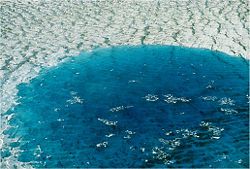
Supraglacial lake
Encyclopedia

Glacier
A glacier is a large persistent body of ice that forms where the accumulation of snow exceeds its ablation over many years, often centuries. At least 0.1 km² in area and 50 m thick, but often much larger, a glacier slowly deforms and flows due to stresses induced by its weight...
. Although these pools are , they may reach kilometers in diameter and be several meters deep. They may last for months or even decades at a time, but can empty in the course of hours.
Lifetime
Lakes may be created by surface melting during summer months, or over the period of years by rainfall, such as monsoons.They may dissipate by overflowing their banks, or creating a crevasse.
Effects on ice masses
Lakes of a diameter greater than ~300 m are capable of creating a fluid-filled crevasse to the glacier/bed interface.When these crevasses form, it can take a mere 2-18 hours to empty a lake, supplying warm water to the base of the glacier - lubricating the bed and causing the glacier to surge
Surge (glacier)
Glacial surges are short-lived events where a glacier can advance substantially, moving at velocities up to 100 times faster than normal. Surging glaciers are clustered around a few areas. High concentrations of surging glaciers can be found in Svalbard, Canadian Arctic islands, Alaska and Iceland...
. The rate of emptying such a lake is equivalent to the rate of flow of the Niagara Falls
Niagara Falls
The Niagara Falls, located on the Niagara River draining Lake Erie into Lake Ontario, is the collective name for the Horseshoe Falls and the adjacent American Falls along with the comparatively small Bridal Veil Falls, which combined form the highest flow rate of any waterfalls in the world and has...
. Such crevasses, when forming on ice shelves, may penetrate to the underlying ocean and contribute to the breakup of the ice shelf.
Supraglacial lakes also have a warming effect on the glaciers; having a lower than ice, the water absorbs more of the sun's energy, causing warming and (potentially) further melting.
- See ice sheet dynamicsIce sheet dynamicsIce sheet dynamics describe the motion within large bodies of ice, such those currently on Greenland and Antarctica. Ice motion is dominated by the movement of glaciers, whose gravity-driven activity is controlled by two main variable factors: the temperature and strength of their bases...
for more on the significance of supraglacial lakes on ice motion.
Context
Supraglacial lakes can occur in all glaciated areas.The retreating glaciers of the Himalaya produce vast and long lived lakes, many kilometres in diameter and scores of metres deep. These may be bounded by moraine
Moraine
A moraine is any glacially formed accumulation of unconsolidated glacial debris which can occur in currently glaciated and formerly glaciated regions, such as those areas acted upon by a past glacial maximum. This debris may have been plucked off a valley floor as a glacier advanced or it may have...
s; some are deep enough to be density stratified.
Most have been growing since the 1950s; the glaciers have been retreating constantly since then.
A proliferation of supraglacial lakes preceded the collapse of the Antarctic Larsen B ice shelf in 2001, and may have been connected.
Such lakes are also prominent in Greenland, where they have recently been understood to be large contributors to ice movement.
Sediments
Sedimentary particles often accumulate in supraglacial lakes; they are washed in by the meltwater or rainwater that supplies the lakes. The character of the sediment depends upon this water source, as well as the proximity of a sampled area to both the edge of the glacier and the edge of the lake. The amount of debris atop the glacier also has a large effect. Naturally, long lived lakes have a different sedimentary record to shorter lived pools.Sediments are dominated by coarser (coarse sand/gravel) fragments, and the accumulation rate can be immense: up to 1 metre per year near the shores of larger lakes.
Upon melting of the glacier, deposits may be preserved as superglacial till (alias supraglacial moraine).
Effect of global warming
It is currently unclear whether global warmingGlobal warming
Global warming refers to the rising average temperature of Earth's atmosphere and oceans and its projected continuation. In the last 100 years, Earth's average surface temperature increased by about with about two thirds of the increase occurring over just the last three decades...
is increasing the abundance of supraglacial lakes; upcoming research hopes to quantify the effect - if any - which the changing climate has.
External links
- Supraglacial lakes of West Greenland in Google EarthGoogle EarthGoogle Earth is a virtual globe, map and geographical information program that was originally called EarthViewer 3D, and was created by Keyhole, Inc, a Central Intelligence Agency funded company acquired by Google in 2004 . It maps the Earth by the superimposition of images obtained from satellite...
.

